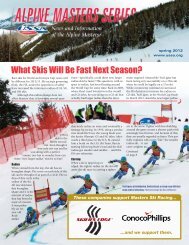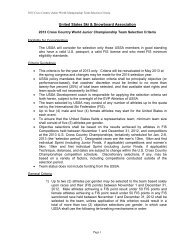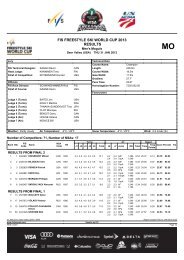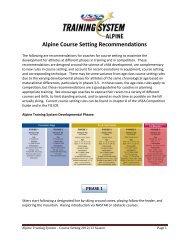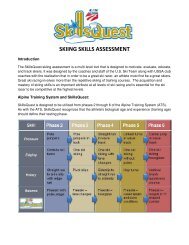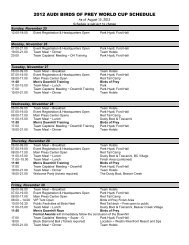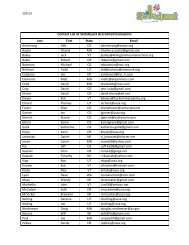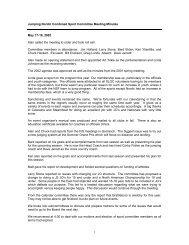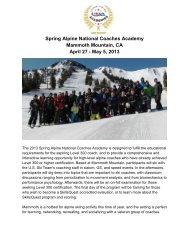THE NUTS AND BOLTS OF KIDS - USSA
THE NUTS AND BOLTS OF KIDS - USSA
THE NUTS AND BOLTS OF KIDS - USSA
You also want an ePaper? Increase the reach of your titles
YUMPU automatically turns print PDFs into web optimized ePapers that Google loves.
<strong>THE</strong> <strong>NUTS</strong> <strong>AND</strong> <strong>BOLTS</strong> <strong>OF</strong> <strong>KIDS</strong>Learning and Teaching Theory by Stacey Gerrish
OUR GOAL – HAPPY <strong>KIDS</strong>
BEAVER CREEK FACTOR! Exceptional experiences lead to exceptionaloutcomes. 940 instructors 1,000 kids a day (groups and privates) Kids make the vacation decision…we make themhappy = job security!
HOW DID WE GET <strong>THE</strong>RE? Programs• Black Diamond Club- Masters of the mountain• Beavo- locals race program Training• Child specific training on teaching and learning theory• Weekly instructor race program• Suggested instructor credentials
COACHING <strong>THE</strong> WHOLE CHILDIncludes: Attitude Motivation Emotion Learning PreferenceIntroducing the CAP Model….
COACHING <strong>THE</strong> WHOLE CHILD The CAP model was developed to help instructorsunderstand and set appropriate expectations foreach child and their parents. Each area of the model is progressive Each area encourages us to observe children anddefine their abilities.
<strong>THE</strong> CAP MODELCognitiveAffectivePhysical
<strong>THE</strong> CAP MODEL All children develop at different rates in the 3 areas. We need to let their development dictate ourbehavior and coaching content.
<strong>KIDS</strong> ARE FUNNY <strong>AND</strong> UNIQUE!
<strong>THE</strong> CAP MODELCognitiveAffectivePhysical
COGNITIVE DEVELOPMENT- HOW CHILDRENTHINK We need to deliver material appropriate to thechild’s stage of thinking to produce the desiredmotor response and skill development. These are common indicators of cognitivedevelopment:Ability to follow directionsSpatial and visual abilitiesLogical and mathematical abilitiesAbility to process specific conceptsVerbal-Linguistic abilities
YEAH BUT WE’RE SKIERS! Understanding how children’s brains receive andprocess information <strong>AND</strong> Knowing how to deliver information that will sparktheir cognitive learning WILL Increase your effectiveness as a coach!
AGES 7 – 12 I do best with ONE direction at a time I need to know “why” I’m asked to do the drill I will ask questions I can learn in a variety of ways I like the process more than the goals I like to be challenged and successful I will remember the highlights of my day!
AGES 13 - 16 I can process more than one direction at a time<strong>AND</strong> I can sequence events I understand right from wrong I can think in abstract terms I can understand complex concepts
PIAGET’S <strong>THE</strong>ORY <strong>OF</strong> 4 STAGES <strong>OF</strong>COGNITIVE GROWTH Sensori-motor (birth – 2 years) Pre-operational (2 – 7 years) Concrete operational (7 – 11 years) Formal operational (11 and older)
CONCRETE OPERATIONAL7-11 YEARS Children now see the world from more than oneperspective. They shift from using their imagination to usingvisualization. They know the difference between reality andmake-believe. They are capable of hypothetical thinking – aneffective teaching tool! Along with visualization. They can think logically about objects and events They can classify and order objects in a seriesalong a single dimension such as size
FORMAL OPERATIONAL 12 YEARS PLUS They can think logically about abstract propositionsand test hypotheses They become concerned with hypotheticalpossibilities, the future and with ideologicalproblems. 2/3rds of people do not develop this form ofreasoning fully so they remain as adults asconcrete operational thinkers.
SO WHAT DO WE NEED TO DO…. Keep instructions simple and focus on one thing ata time, children will tend to focus on the lastthing they heard. The timing of instructions is important! Best to givefeedback or information before and/or after theyattempt a movement, not while they are doing it.(Soccer parents violate this a lot!) Their mental circuit breaker will easily overload!
ABILITY TO FOLLOW DIRECTIONS Is based on where their development is withrespect to 3 mental processes.REVERSIBILITY- the process of turning directions orthought processes backwards. Usually developedduring concrete operations stage.LATERALITY – the preference we show for one sideof our body over the other. Usually developed byages 5 or 6.DIRECTIONALITY- includes an understanding ofwhat is “left” and “right” for another person.
MULTIPLE INTELLIGENCES PROPOSED BYHOWARD GARDNER Gardner says intelligence has to do with thecapacity for solving problems and fashioningsolutions. He groups human capabilities into 8 comprehensivecategories (multiple intelligences)1. linguistic (word-smart)2. logical-mathematical (number-smart)3. spatial (picture-smart)4. bodily-kinesthetic (body or sport smart)5. musical (music-smart)6. interpersonal (people-smart)7. intrapersonal (self-smart)8. naturalist (nature-smart)
MULTIPLE INTELLIGENCES DEFINED AS.. The identity one’s brain assigns to an incomingstimulus from the senses, the response it selectsand what details the brain stores as a memory ofthe experience. Similarities exist between this informationprocessingsystem and the learning preferences WATCHER, DOER, FEELER, THINKER
MULTIPLE INTELLIGENCES This theory is primarily concerned with how thehuman mind solves problems, rather than on themode of sensory input. For example – it’s possible to be blind and still havespatial intelligence, or to be deaf yet musical. You can enhance the learning of your athletes byconsidering all the ways of learning.
INTELLIGENCE DEVELOPMENT Most people develop all their intelligences to a levelof relative competence; however, we all prefer tolearn in certain ways. Experience with different coaches helps us to figureout the way in which we prefer to learn. Our experiences, combined with our biologicalmakeup are key factors in the types of intelligencesin which we excel.
INTELLIGENCE ORGANIZER Make a note for yourself by writing down each ofthese words that is true for your way of knowing. Seeing Reading Drawing Speaking Action Writing Listening Touching Thinking
IT’S OUR JOB… As coaches to provide opportunities for the athletesto have experiences that exert positive impacts onlearning and to avoid negative impacts. A great way to identify a child’s best-developedintelligence is to observe what the individual doeswhen “off-task”. (chatting at top of run) Word-smart will be talking, picture smart will bedoodling in the snow, people-smart will besocializing and the body-smart will be fidgeting. They are letting you know through their behaviorhow they learn.
WHAT OUR COGNITIVE DEVELOPMENTINVESTIGATION REVEALS… How children use each component of intelligence tothink or process information. What types of things they enjoy doing What coaching strategy we should employ to meettheir needs.
<strong>THE</strong> CAP MODELCognitiveAffectivePhysical
AFFECTIVE DEVELOPMENT- HOW CHILDRENDEVELOP EMOTIONALLY Coaches need to satisfy emotional needs toconnect with children and enhance their motivationlevel. Meeting affective needs is a priority These are affective traits and indicators of a child’saffective development and needs:• Internal beliefs and values (intrapersonal)• Teamwork and sportsmanship (interpersonal)• Identity and self-esteem• Humor• Play, rules and competition (social interaction)• Moral values
AFFECTIVE (SOCIAL/EMOTIONAL)DEVELOPMENT Affects how individual children feel aboutthemselves and how they interact with others. Self-identity is largely shaped by social interactions The development of moral values is closely tied tothe development of self identity.
COACHES BEHAVIORS<strong>AND</strong> PERFORMANCEINFLUENCE LEARNING Carefully introduce competition and play in atraining session Use humor not sarcasm Make an effort to understand how your athletesthink and feel about themselves, others and theworld
AGES 7-12 I want ownership in my day and can workindependently I compare my achievements to those of my peers I want to have fun and I like to play games I like to be responsible for my learning I like to know when I’ve done something well
AGES 13 -16 I don’t like to be singled out, even if I am the best inthe group. I like to blend in with everyone else. I want to be treated with respect and not talkeddown to. I may not respect authority and will test myindependence. I want to have fun while improving skills andattaining goals. I want to be part of the group and accepted by mypeers. I want to take part in decision making.
AFFECTIVE DEVELOPMENT Progresses through stages as they develop andgrow. Children have a wonderful ability to find humor inthings most adults don’t view as funny at all. Being silly is an integral part of a child’s learning. If presented with information in a fun, creative way,and then encouraged to demonstratecomprehension in a light-hearted manner, the childis more likely to retain the concept and be receptiveto more of the same. For example, ask them to come up with a new wayto “ski like a banana”
AFFECTIVE AWARENESS One way children discover limits for themselvesand others is to poke fun at each other. Coaches need to monitor this behavior to ensureany teasing is harmless and kept to a minimum. We can model how to laugh at ourselves with thefunny or embarrassing things we sometimes do. Sarcasm can be devastating and may ruin the bestexperience. 8-12 year olds often use sarcasmineffectively.
PLAY, RULES, <strong>AND</strong> COMPETITION Play is fun and critical to the learning process. Ages 7-11 they become interested in results as wellas participation. Rules take on more importance. Ages 7-11 drills and tasks have better results ifstructured in a game format and involves everyoneall of the time. Ages 7-11 use drills with a group focus and acommon goal. They get more tired waiting thanparticipating. Forced stillness may feel likepunishment to them. Outcome and rules can be externally motivating,when the desire is to please others.
PLAY, RULES <strong>AND</strong> COMPETITION Older children- competition is a way to evaluateself-improvement and will enhance intrinsicmotivation. Older children are able to notice self-improvementand recognize feelings of success.
<strong>THE</strong> EMERGENCE <strong>OF</strong> MORALITY Moral values are closely tied to self-identity As with competition the focus shifts from external tointernal As children mature their morals shift from pleasingothers to what is valued by self.
CLEVERNESS Around the ages of 7-11 children reach a point ofcognitive conceit. They may respect you as anauthority figure but they may also have little respectfor your intelligence. Children in this stage usually believe in their owncleverness and view adult imposed rules assomething to challenge. Adults quite often exhibit this behavior too! (speedlimit)
ALL IN FAVOR SAY “AYE” Pre-teen and tween years – peer pressure plays abig role in behavior. Good and bad are determined by socially agreedupon standards. They are searching for the identity and acceptancethat comes from groups. The coaches challenge with this age is to maintaingroup dynamics. Have the group follow cooperative rule-making,rules are discussed and decided upon.
LISTEN TO YOUR CONSCIENCE Good and bad become important to an individualand involve the abstract concepts of justice, dignityand equality. An older child understands its ok to change therules if everyone agrees.
CREATING <strong>THE</strong> ENVIRONMENT FOR AFFECTIVEGROWTH Crucial to the learning process Emotion drives attention which in turn driveslearning and memory The affective or social-emotional environment helpsenhance children’s positive feelings aboutthemselves and can inspire them.
TEACHING MODELIntroductionSummaryDetermineGoalsCheck forUnderstandingPresentInformationPractice
<strong>THE</strong> WAY WE THINK <strong>AND</strong> FEEL IMPACTS OURPERFORMANCEThe Limits of PerfectionPerfection and self-esteem basedon a standardBased on being rightFear of failureUnwillingness to take risksFrustration and anxietyExcessive controlJudgment of self and othersWork and StruggleThe Power of DiscoverySelf-esteem based on inquiry,creativity and participationBased on learningNo failure- just an outcomeWillingness to do whatever isappropriateFascination and enjoymentSpontaneityAppreciation of self and othersPlay and fulfillment
ITS MORE THAN COACHING <strong>THE</strong>TECHNIQUE <strong>OF</strong> SKI RACING!Coaches teach the rules and strategies ofskiing, racing <strong>AND</strong> important life lessons aswell.
YOUR TIME ON <strong>THE</strong> SNOW COACHINGCAN HELP DEVELOP…ConfidenceSelf- esteemSafety and well-beingSkills for communicating with othersSuccessful ski racers!
YOUR COACHING IMPACTS MOTIVATION….Self DirectionSensationAffiliationAchievement
ASK LISTENShapeShowObserve
EFFECTIVE COACHING IS… Playful and relevant to:the athletes ageCognitive developmentAffective needsgoals and motivations When coaching is effective the technicalimprovement happens seamlessly.
RESOURCESPSIA Children’s Instruction ManualPSIA Children’s Teaching HandbookPathways of Learning, David Lazear



